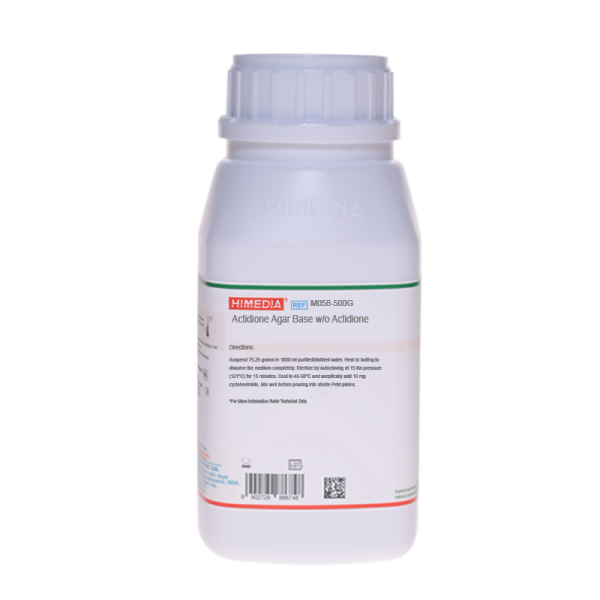 Your enquiry has been submitted
Your enquiry has been submitted
Actidione Agar Base w/o Actidione®
Intended Use
Recommended for the enumeration and detection of bacteria in specimens containing large numbers of yeasts and moulds.
Composition
| Ingredients | Gms / Litre |
|---|---|
| Tryptone | 5.000 |
| Yeast extract | 4.000 |
| Dextrose (Glucose) | 50.000 |
| Potassium dihydrogen phosphate | 0.550 |
| Potassium chloride | 0.425 |
| Calcium chloride anhydrous | 0.125 |
| Magnesium sulphate | 0.125 |
| Ferric chloride | 0.0025 |
| Manganese sulphate | 0.0025 |
| Bromo cresol green | 0.022 |
| Agar | 15.000 |
Final pH (at 25°C): 5.5±0.2
**Formula adjusted, standardized to suit performance parameters
Directions
Suspend 75.25 grams in 1000 ml purified / distilled water. Heat to boiling to dissolve the medium completely. Sterilize by autoclaving at 15 lbs pressure (121°C) for 15 minutes. Cool to 45-50°C and aseptically add 10 mg/l Actidione to the medium. Mix well before pouring into sterile Petri plates.
Warning: Cycloheximide (Actidione) is very toxic. Avoid skin contact or aerosol formation and inhalation.
Principle And Interpretation
Actidione Agar was formulated by Green and Gray (1) which may be used for microbiological investigation during brewing and baking. Actidione® (Cycloheximide) at a concentration of 0.001% permits the growth of bacteria and inhibits the growth of most yeasts and moulds except dermatophytes. This medium may be used for the estimation of bacterial contamination of pitching yeast. Addition of penicillin or streptomycin may be used for selective isolation of dermatophytes.
Tryptone acts as source of nitrogen while yeast extract is a rich reservoir of vitamins. Dextrose in high amount along with mineral salts at acidic pH favours sugar fermentation.
Type of specimen
Brewing sample.
Specimen Collection and Handling
For Brewing samples, follow appropriate techniques for sample collection, processing as per guidelines and local standards. (1).
After use, contaminated materials must be sterilized by autoclaving before discarding.
Warning and Precautions
Read the label before opening the container. Wear protective gloves/protective clothing/eye protection/ face protection. Follow good microbiological lab practices while handling specimens and culture. Standard precautions as per established guidelines should be followed while handling specimens. Safety guidelines may be referred in individual safety data sheets.
Limitations
- Further Biochemical tests must be carried out for confirmation.
- Cycloheximide (Actidione) is very toxic. Avoid skin contact or aerosol formation and inhalation.
Performance and Evaluation
Performance of the medium is expected when used as per the direction on the label within the expiry period when stored at recommended temperature.
Quality Control
Appearance: Light yellow to light green homogeneous free flowing powder
Gelling: Firm, comparable with 1.5% Agar gel
Colour and Clarity of prepared medium: Greenish blue clear to slightly opalescent gel forms in Petri plates
Reaction: Reaction of 7.53% w/v aqueous solution at 25°C. pH : 5.5±0.2
pH: 5.30-5.70
Cultural Response
Cultural characteristics observed after an incubation at 25-30°C for 40-48 hours.
| Organism | Inoculum (CFU) | Growth (Plain) | Recovery | Growth (w/ Actidione) | Recovery (w/ Actidione) |
|---|---|---|---|---|---|
| Escherichia coli ATCC 25922 (00013*) | 50-100 | luxuriant | >=70% | good-luxuriant | >=50% |
| Lactobacillus fermentum ATCC 9338 | 50-100 | luxuriant | >=70% | good-luxuriant | >=50% |
| Proteus mirabilis ATCC 25933 | 50-100 | luxuriant | >=70% | good-luxuriant | >=50% |
| Saccharomyces cerevisiae ATCC 9763 (00058*) | 50-100 | luxuriant | >=70% | inhibited | 0% |
| Saccharomyces uvarum ATCC 9080 | 50-100 | luxuriant | >=70% | inhibited | 0% |
Key: (*) Corresponding WDCM numbers.
Storage and Shelf Life
Store between 10-30°C in a tightly closed container and the prepared medium at 2-8°C. Use before expiry date on the label. On opening, product should be properly stored dry, after tightly capping the bottle in order to prevent lump formation due to the hygroscopic nature of the product. Improper storage of the product may lead to lump formation. Store in dry ventilated area protected from extremes of temperature and sources of ignition. Seal the container tightly after use. Use before expiry date on the label.
Product performance is best if used within stated expiry period.
Disposal
User must ensure safe disposal by autoclaving and/or incineration of used or unusable preparations of this product. Follow established laboratory procedures in disposing of infectious materials and material that comes into contact with sample must be decontaminated and disposed of in accordance with current laboratory techniques (2,3).
Reference
- Green, S.R. and Gray, P.P., 1950, Wallerstein Lab. Communication, 13:357.
- Isenberg, H.D. Clinical Microbiology Procedures Handbook 2nd Edition.
- Jorgensen, J.H., Pfaller, M.A., Carroll, K.C., Funke, G., Landry, M.L., Richter, S.S and Warnock., D.W. (2015) Manual of Clinical Microbiology, 11th Edition. Vol. 1.
| Product Name | Actidione Agar Base w/o Actidione® |
|---|---|
| SKU | M058 |
| Product Type | Regular |
| Physical Form | Powder |
| Origin | Animal |
| Packaging type | HDPE |
| References | 1.Green, S.R. and Gray, P.P., 1950, Wallerstein Lab. Communication, 13:357. |
| Customized Product Available | No |





